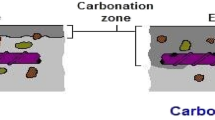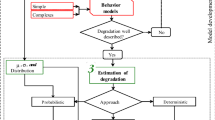Abstract
This paper presents a conceptual framework methodology concerning service life prediction of concrete structures by using deterministic or probabilistic processes, which are included from collecting data until the decision-making. This methodology provides guidelines to generate new degradation models and accomplish new service life studies of either existing structures or new ones in literature. In the first case, it is possible to estimate how many years are necessary for the structure to reach the desired limit state (durability, service or of security). It can also provide support in project design by selecting durability requirements such as covering thickness, concrete strength, type of cement, water–cement ratio, among other factors that influence the service life of concrete structures.





Similar content being viewed by others
References
Garcia-Alonso MC et al (2010) Corrosion behaviour of new stainless steels reinforcing bars embedded in concrete. Cem Concr Res 37:1463–1471. https://doi.org/10.1016/j.cemconres.2007.06.003
Mehta PK, Monteiro PJM (2014) Concrete: microstructure, properties, and materials, 4th edn. McGraw-Hill, New York
NACE International—THE NATIONAL ASSOCIATION OF CORROSION ENGINEERS (2002) Corrosion costs and preventive strategies in the United States. FHWA-RD-01-156. http://www.nace.org/nace/content/publicaffairs/cocorrindex.asp, Accessed 05 May 2008
Meira GR, Padaratz IJ (2002) Custos de recuperação e prevenção em estruturas de concreto armado: uma análise comparativa. In IX, Encontro Nacional de Tecnologia do Ambiente Construído, pp 1425–1432
Andrade JJO, Possan E, Dal Molin DCC (2017) Considerations about the service life prediction of reinforced concrete structures inserted in chloride environments. J Build Pathol Rehabilit 2(6):1–8. https://doi.org/10.1007/s41024-017-0025-x
Pang L, Li Q (2016) Service life prediction of RC structures in marine environment using long term chloride ingress data: comparison between exposure trials and real structure surveys. Constr Build Mater 113:979–987. https://doi.org/10.1016/j.conbuildmat.2016.03.156
Possan E (2010) Carbonation modeling and service life prediction of concrete structures in urban environment. Porto Alegre. Engineering School, Federal University of Rio Grande do Sul. PhD Thesis in Engineering
Dal Molin DCC, et al (2016) Contribuição à Previsão da Vida Útil de Estruturas de Concreto. Avaliação de Desempenho de Tecnologias Construtivas Inovadoras: Materiais e Sustentabilidade. s.l.: Editora Scienza, pp 223–270. http://dx.doi.org/10.5935/978-85-5953-005-6.2016C008
FIB Bulletin 53 (2010) Model code for structural concrete textbook on behaviour, design and performance. Fédération Internationale du Béton, vol 3, p 390, Design of durable concrete structures
International Organization for Standardzation. ISO 13823 (2008) General principles on the design of structures for durability. ISO/TC, 2008, Geneva
British Standards Institution. BS 7543 (2015) Guide to durability of buildings and building elements, products and components. British standards institution, London, United Kingdom
Associação Brasileira de Normas Técnicas. ABNT NBR 15575 (2013) Desempenho de Edifícios Habitacionais. Partes 1-6. Rio de Janeiro
International Organization for Standardization. ISO 16204 (2012) Durability, service life design of concrete structures: general information. Switzerland
Clifton JR (1990) Methods for predicting the remaining service life of concrete. In: 5th International conference—durability of building materials and components, Brighton, United Kingdom, pp 361–373
Helene PRL (1997) Vida útil das estruturas de concreto. In: VI Congresso de controle de qualidade – CONPAT, Porto Alegre: Rio Grande do Sul, Brasil
Andrade JJO (2001) Contribution to the service life prediction of reinforced concrete structures affected by reinforcement corrosion: initiation by chlorides. PhD Thesis in Engineering, Engineering School, Federal University of Rio Grande do Sul
Rostam S (2005) Service life design of concrete structures: a challenge to designers as well as to owners. Asian J Civil Eng (Build Hous) 6(5):423–445
Baroghel-Bouny V (2014) Durability indicators: a basic tool for performance—based evaluation and prediction of durability. In: Proceedings of international seminar on durability and lifetime evaluation of concrete structures, Higashi-Hiroshima
Possan E (2004) Contribuição ao estudo da carbonatação do concreto com adição de sílica ativa em ambiente natural e acelerado. Porto Alegre, PRPPG (UFRGS), p 153
Morgan DL (1997) Focus groups as qualitative research: qualitative research methods. Sage Publications, London
Altmann F et al (2012) A fuzzy-probabilistic durability concept for strain-hardening cement-based composites (SHCCs) exposed to chlorides Part 1: concept development. Cem Concr Compos 34:754–762. https://doi.org/10.1016/j.cemconcomp.2012.02.014
Shier DR, Wallenius KT (1999) Applied mathematical modeling: a multidisciplinary approach. CRC Press, Boca Raton
Bender EA (2000) Introduction to mathematical modeling. Dover Publications, New York
Muntean A, et al (2005) A note on limitations of the use of accelerated concrete-carbonation tests for service-life predictions. Universität Bremen, pp 1–15
Thiéry M (2005) Modélisation de la carbonatation atmosphérique des bétons: Prise en compte des effets cinétiques et de l’état hydrique. Ecole Nationale des Ponts et Chaussées. Thèse de doctorat, Paris
Pauletti C (2009) Estimate of natural carbonation of cement materials based on accelerated tests and prediction models. PhD Thesis in Engineering. Engineering School, Federal University of Rio Grande do Sul, Porto Alegre
Duan A, Dai J, Jin W (2015) Probabilistic approach for durability design of concrete structures in marine environments. J Mater Civil Eng. https://doi.org/10.1061/(ASCE)MT.1943-5533.0001023
Siemes T (1985) Durability: a probabilistic approach. Durab Build Mater 3(2):101–113
Da Silva TJ (1998) Predicción de la Vida Útil de Forjados Unidireccionales de Hormigón Mediante Modelos Matemáticos de Deterioro. Tesis Doctoral. Universidad Politécnica de Catalunya, Barcelona
Noortwijk JMV, Frangopol DM (2004) Two probabilistic life-cycle maintenance models for deteriorating civil infrastructures. Probab Eng Mech 19:345–359. https://doi.org/10.1016/j.probengmech.2004.03.002
Possan E, Andrade JJO (2014) Markov chains and reliability analysis for reinforced concrete structure service life. Mater Res 17:593–602. https://doi.org/10.1590/S1516-14392014005000074
Felix EF, Possan E, Carrazedo R (2017) Análise paramétrica da carbonatação em estruturas de concreto armado via Redes Neurais Artificiais. REVISTA ALCONPAT 7:302–316. https://doi.org/10.21041/ra.v7i3.245
Frangopol DM, Lin K-Y, Estes AC (1997) Life-cycle cost design of deteriorating structures. J Struct Eng 123:1390–1401. https://doi.org/10.1061/(ASCE)0733-9445(1997)123:10(1390)
LIFECON (2003) Methodology and data for calculation of life cycle costs (LCC) of maintenance and repair methods and works. Deliverable 5.2. Project G1RD-CT-2000-0037
Ferreira RM, Jalali S (2006) Software for probability-based durability analysis of concrete structures. In: Concrete Repair, Rehabilitation and Retrofitting. Taylor & Francis Group, London
Possan E, Felix EF, Thomaz WA (2016) CO2 uptake by carbonation of concrete during life cycle of building structures. J Build Pathol Rehabilit 1:7. https://doi.org/10.1007/s41024-016-0010-9
Guimarães ATC (2000) Service life of reinforced concrete structures in marine environment. D.Sc. thesis, USP, São Paulo
Acknowledgements
The authors thank National Council for Scientific and Technological Development (CNPq) to support the doctoral scholarship.
Author information
Authors and Affiliations
Corresponding author
Rights and permissions
About this article
Cite this article
Possan, E., Dal Molin, D.C.C. & Andrade, J.J.O. A conceptual framework for service life prediction of reinforced concrete structures. J Build Rehabil 3, 2 (2018). https://doi.org/10.1007/s41024-018-0031-7
Received:
Accepted:
Published:
DOI: https://doi.org/10.1007/s41024-018-0031-7




